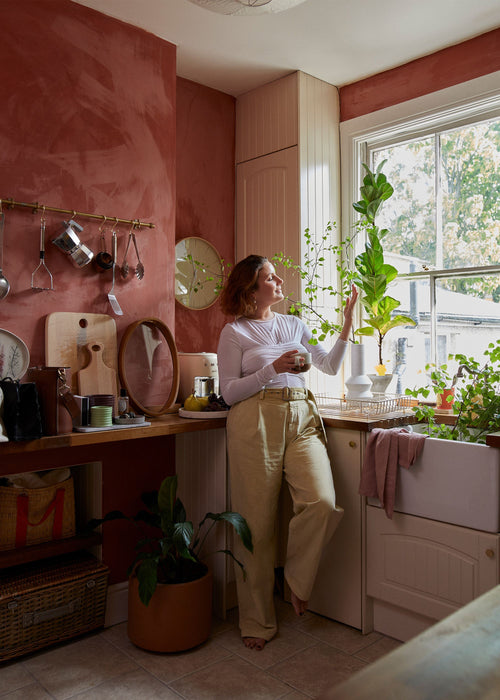5 Simple (and Safe) Ways to Add More Raw Food Into Your Diet
2019 was all about the keto diet, then intermittent fasting took over in 2020 and now 2021 seems to be the year everyone is obsessed with incorporating more plant-based foods into their diet.
While a flexitarian and vegan approach have proven to be the most popular methods to reducing consumption of animal products, the raw food diet has quickly gained traction - and for all the right reasons.
Here, the founder of award-winning raw food cafe Earth to Table and author of ’Eat More Raw’ Julie Mitsios, gives a full rundown on what the raw food diet is, the benefits and risks, and shares simple tips on how you can incorporate more raw foods into your weekly meal plan.
What is the raw food diet?
As the name implies, a raw food diet typically consists of 70 per cent or more of the diet consisting of raw food. It’s based on a theory that eating uncooked and unprocessed food can lead to an improved general wellbeing and even prevent chronic diseases. The diet suggests that cooking breaks down the enzymes in uncooked or “live food”, which aid in digestion and absorption of nutrients.
It’s not a new concept, either, and may even be one of the oldest ways of eating known to humankind.
“Going back to the 1800s, the raw food movement itself originated during the Natural Hygiene movement, which was led by a group of physicians who rejected orthodox medical practice and instead dedicated themselves to teaching people how to live disease-free lives,” Mitsios explains. “A key component of their beliefs strongly echoed the idea of Hippocrates, ‘let food be thy medicine’.”
Although the thought of giving up ‘hot’ meals doesn’t seem entirely enticing, there is actually heating involved at very low temperatures (no more than 46 degrees Celsius).
“Scientifically speaking, by not heating foods beyond this point, we are able to preserve valuable nutrients, enzymes and the life force of the food, ultimately keeping it in its most natural, healthy form,” Mitsios says.
“In essence, eating raw foods means enjoying foods in their most pure, unaltered state - the way nature has so perfectly brought them to us, bursting with living nutrients and goodness.”
Followers of the raw food diet may have begun as vegetarian or vegan before making the switch to mostly raw foods. While it’s common for those of a raw food diet meal plan to be completely vegan, there are ‘raw foodists’ who consume raw animal products such as raw dairy, fish or meat products.
What are the benefits of a raw food diet?
“The goal of eating food in its raw state is to maximise our assimilation of its vitamins and minerals,” Mitsios tells Bed Threads Journal. “Enzymes which aid in the digestive process tend to be killed in the cooking process. By eating foods in their raw natural state, we are able to access more of the nutrients.”
Some of the benefits of eating more raw foods include:
- Increased energy and vitality
- Stronger immune system
- Better digestion
- Improved hydration and avoid/alkaline balance
- Glowing skin
- Disease prevention
What are the risks of a raw vegan diet?
As with any diet, there are risks involved - especially if you don’t plan it well. It’s also important to note that some foods actually become more digestible and nutritious after cooking because the fibrous protein is broken down.
According to Healthline, the main risks associated with the raw food diet include:
- Nutrition imbalance - specifically vitamin B12, calcium and vitamin D
- Weak muscles and bones
- Tooth decay
- Reduced fertility
Instead of going all in and completely cutting out cooked foods, start by incorporating one raw meal a day such as a smoothie for breakfast or fresh salad for lunch.
Moreover, consult with your registered dietitian or healthcare expert prior to starting a new eating plan.
What can you eat on the raw food diet?
The important concept is that the food needs to be ‘living’, meaning it needs to be alive. Living raw foods include:
- Organic fresh fruits and vegetables
- Sprouted grains and legumes
- Cultured and fermented foods
- Cultured and fermented foods
- Superfoods (for example, maca, spirulina and lucuma)
Low-temperature cooked foods include:
- Cold-pressed olive oil and coconut oil
- Breads
- Granolas
- Dehydrated crackers
What can’t you eat on a raw food diet?
Foods you should avoid include:
- Foods heated above 46 degrees Celsius
- Refined, processed or pasteurised foods
- Foods treated with pesticides
- Caffeine, energy drinks, sodas and soft drinks
- Iodised white table salt
How to incorporate more raw vegan food into your diet
Incorporating more raw foods into your diet isn’t as difficult as it seems. The key is to plan your meals in advance. Here are Mitsios’ top five tips:
1. Start slowly
You don’t have to give up animal products entirely (or low-heat cooking) to reap the benefits of the raw food diet.
Mitsios says it’s best to “start slowly by replacing foods that you find will make the biggest impact as it’s much easier to find healthier alternatives than it is to completely cut something out.”
2. Find healthier alternatives
“If you want to eliminate sugar, you can easily find natural sugar alternatives such as fruit, dried fruit, stevia, coconut sugar and monk fruit. These are all natural sugars that are still sweet so you don’t feel like you’re missing out.” You can also replace sugary drinks with kombucha or kefir, which also come packed with probiotics (hello, happy gut!)
For those wishing to eliminate dairy, there are also plenty of alternatives. “Substituting milk for nut milks, regular cheese for tree nut cheese, and cheesecakes for raw cheesecakes made from cashews,” are a few examples.
3. Kickstart the day with a smoothie
Mitsios adds that a raw breakfast is a great way to start the day. “I find starting the day with a raw breakfast is really easy as there are so many options that make it really achievable such as smoothie bowls, raw granolas, fresh fruit and filling smoothies.”
4. Get creative with lunch and dinner
A salad filled with colourful veggies for lunch will fill you up on good nutrition, as will a more creative dinner option such as a raw zucchini pasta or a raw Shepherd's pie.
5. Swap your 3pm coffee (or chocolate cake) for a raw treat
As for that afternoon slump? Raw vegan treats aren’t that difficult to make or source from your nearest grocery store.
Always seek the guidance of your doctor, dietitian or other qualified health professional prior to starting a new eating plan.
Julie Mitsios is the creator of the award-winning raw food cafe Earth to Table. Julie’s mission is to inspire and empower others to enjoy a raw food lifestyle easily in their own homes through her book Eat More Raw ($59.95). Follow Julie on Instagram @juliemitsios or visit her site here.
Lead image from Eat More Raw.


















